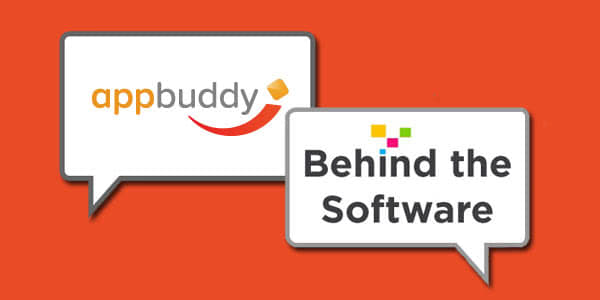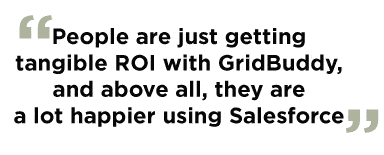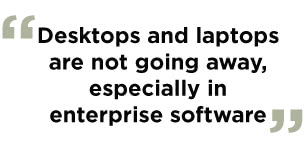Business Intelligence
Let's Talk AppBuddy: Behind the Software with CEO Marc Aubin

I first met Marc Aubin, CEO and co-founder of AppBuddy, at Dreamforce 2013, where I was struck by his authentic desire to make customers happy. The company’s flagship product, GridBuddy, helps Salesforce users manage related objects and make better sense of data. These improvements translate into greater Salesforce adoption rates and more efficient, productive employees—benefits that have been confirmed in the company’s rave reviews within the Salesforce community. Read on to see what Aubin has to say about AppBuddy’s philosophy, add-ons and future plans.
How did you get the idea for AppBuddy? And what void in the market were you seeking to fill?
Our background is as consultants, and as consultants, you often find yourselves building the same things over and over. We started working on the Salesforce platform in 2006, and there were certain problems we noticed—mainly that it is hard to work with related data, and that it was hard to mass-manage data with the tools provided. We saw this as a larger problem, having to do with bad user experience working with relational data, which we have not only seen with Salesforce, but also with other enterprise systems.
WEBSITE: www.appbuddy.com
LAUNCHED: 2009
LOCATION: Campbell, CA
CUSTOMERS: NetApp, Caterpillar, Motorola Mobility, AOL
You can break this problem down into three different parts: One is that when you’re working with relational data, it’s really hard to visualize the data that you need to see when the data is not in view. A lot of these systems are form-based and form-heavy. Since you work with one record at a time, it is really hard to know how that data works with other data.
That brings us to the second problem, which is a lack of clarity. It is hard to know what data means when it’s not in context, especially in relational systems. Clarity is important especially for companies that are dealing with a lot of custom objects and the business processes that are specific to them. Lastly, we saw an issue with actionability. In many cases, it’s really difficult to act in Salesforce; it’s really unproductive and it’s confusing. To make fast and accurate decisions, you really need to be able to work with related data on one screen, and you need to have all of the data that you’re going to be acting on in view, so that you avoid what’s called the action-in-distance problem (when you can’t make a decision if you can’t see the results of it).
What we’ve seen is that bad user experience leads to bad user adoption and bad data quality; people just don’t like editing data is Salesforce, and then they end up not using it as effectively as the companies hope. This is why we came out with GridBuddy. We wanted to empower users and business units to work with relational data and business systems in a simple and efficient way, without having to develop solutions to fix that problem.
So tell me a little bit more about what AppBuddy’s products do.
We are pretty focused on the Salesforce platform, so our products integrate with Salesforce features and are fully configurable. Our main flagship product is called GridBuddy. Basically it’s a configurable user interface where users can see multiple objects in Salesforce on one page, where they are presented in a hierarchical view (a view that’s very similar to a reporting tool). Users can filter and hone in on data as they might with a reporting tool, and can act on data just as they would in a spreadsheet; they can edit, create and delete data.
We do this all on top of a point-and-click, configurable framework that works with virtually any Salesforce object. We fulfill the gambit of use cases, and we have customers in nearly every industry and every size, from enterprise customers on down to small-size customers.
Could you expand on how GridBuddy interacts with the Salesforce platform?
GridBuddy plays very well not only with any process or object in Salesforce, but it plays well with a lot of other AppExchange applications. For instance, we have a partnership with Conga, where you can configure Conga actions directly in GridBuddy. We have worked with custom apps that people develop internally, and we have an add-on for Milestones PM that is available both on the AppExchange and on the AppBuddy website.
We also have a whole fleet of add-ons for our own products. They’re basically the starter templates for specific-use cases, as well as other Salesforce applications. We worked with MRP apps and other accounting apps on the AppExchange.
How you would describe your company’s philosophy as well as key goals?
I think any company’s philosophy is that they want to fulfill needs for customers; they want to help customers achieve their business goals. We want to do this too, but the core philosophy behind our company and how we build our products (and how we help and interact with our customers) is that we want to alleviate suffering.

Almost everyone has had this experience where they sit behind their computers, and after working with a certain software application, they just start cussing at their computer and getting frustrated. They don’t look forward to their jobs, and they feel like one more thing in their very stressful lives isn’t going to help them. Our whole philosophy is to take suffering away; to take away that situation, replace it with a better situation, and make people happy. When you get down to it, that’s eventually what’s going to make your data quality better.
When we spoke at Dreamforce, I was really struck by how customer-centric your company appears. You mentioned that AppBuddy has customers in all industries, but when developing GridBuddy did you have an ideal customer in mind?
As far as an ideal customer, we focus on the Salesforce market. I think the customer who gets the most benefit out of our app is anyone who uses Salesforce and isn’t 100-percent happy with either the manual data management experience or the tools Salesforce provides out-of-the-box to customize the data management user experience. Also, these customers don’t want to reinvent the wheel every time they need to develop a custom page.
We definitely do work with people who have development staff, but customers who are already 100-percent happy with the application and just want to develop everything themselves aren’t our ideal customers.
How has your desire to alleviate customers’ suffering changed GridBuddy? Has this focus impacted the development process?
Absolutely, yes. Let me put it this way—I think 90 percent of the features that we put into our product have been asked for by our customers. This has been true for almost all of the four years that we have been in business. Also, for certain features, we have a vision for how the user experience should be and we want to lead with those features. So, we go out there and we actively get some of our customers’ feedback both before developing them and while we are designing them. We really look at our customer relationships as a partnership.
What benefits do customers gain by switching to GridBuddy from other competitor solutions?
I guess the problem that we are really fixing is the process of data complexity. There are a few specific costs that have to do with data complexity. One of them is data quality and accuracy. Users are making errors in data entry or are not getting it done because they don’t know what they’re doing and they’re taking too long to do it. We help by providing a contextual view that is very efficient for them, where they end up wanting to own the data that’s closest to them. When users truly own the data that’s closest to them, data quality improves.
GridBuddy also helps users gain productivity. We really help organizations be more productive with manual data management in Salesforce. We have organizations like NetApp that has thousands of users. They said that each of their sales users are realizing up to 12 hours of savings per month, and that really adds up in an organization like NetApp. Some other organizations have reported (for the processes that they implemented) anywhere from 80 to 90 percent time savings. This is absolutely not uncommon. We’re giving businesses and users better tools to help them do the jobs that they need to do.
GridBuddy also really helps with user adoption in Salesforce. We’ve worked with some smaller organizations that had almost no adoption in Salesforce. After they implemented GridBuddy, they had up to almost 100 percent adoption of Salesforce, which is really fantastic for an organization that utilizes a team of 20 salespeople. Anybody who has managed 20 salespeople knows that that number is not trivial.
We also help customers by providing low development costs. Organizations—especially our major enterprise organizations—have actually tried to develop solutions to solve the problems we solve. Eventually they say, “We’re actually going to scrap what we do. We work with you guys because we can save thousands of dollars, if not hundreds of thousands of dollars,” which is the case with some of our larger customers and organizations. Companies benefit from using GridBuddy instead of having to develop this from scratch and maintain it over time themselves.
One thing I really encourage everybody to do is check out our reviews, because if you look at our reviews, you see all this validated. People are just getting very tangible ROI with GridBuddy, and above all, they are also a lot happier using Salesforce.
What makes GridBuddy stand out from its competitors?
I think a few things together really contribute to how we stand out from our competitors. One is that we take responsibility in our customer and partner relationships. We really focus on diving into our customers’ problems and helping them all the way through in the best way that we can.
As far as how we look at software development, we like to take what we call an outside-in perspective, which really focuses on customers and the user experience. You can see this in the sense that we think that we are the best solution out there for managing related objects in Salesforce. We bring this outside-in perspective to an experience of managing related objects on one configurable screen. If you don’t fix this problem and fail to provide the experience to work with relational data that works for the gambit of users (not just power users), then your solution is limited. Basically our philosophy on software is that you should have repeatable, configurable solutions that you can implement over and over again. These solutions are generic and you can do multiple use cases with them, because that’s how you get ROI that scales with use.
Finally, we really just have some great experience on the Salesforce platform. We been working on it since 2006, and we’ve been working on enterprise systems for the past 15 years. If you have a solution on the AppExchange, it has to integrate with the Salesforce features tightly, and GridBuddy does that.
How have social and mobile trends impacted AppBuddy’s product or success?
As far as social and mobile trends, mobile has definitely impacted our product development cycle. We have some pretty major healthcare customers that have asked for iPad optimization and are using GridBuddy on iPad. We responded with iPad optimization for our app, and we definitely have plans for a mobile phone version in the future.
As far as social, it’s definitely helped us just like it’s helped other companies get their messages out there. I think social trends have really helped us get a great reputation in the Salesforce community. You see this in our reviews, in the Salesforce communities and in how people talk about us on LinkedIn. Our customers even chime in on LinkedIn and say that GridBuddy is the way to go. They say, “You’ve got to check this thing out.” I couldn’t ask for better community support. I think social is just an extension of being a good human being; It’s really about building a relationship with a community that you’re trying to make a better place.
Have you noticed any important trends that your users or our readers should be aware of?
Yeah, I’ll just mention one. It’s kind of funny because there’s a lot of hype around mobile. But desktops and laptops are not going away, especially in enterprise software. For people who are working at their desks (even if their desks are at home), there’s a certain point where you need to get a lot of things done. Mobile apps are just not at the point yet where typing with two thumbs is really more productive than doing things on the computer.
We started prototyping a mobile application, and we still have plans to go there. But we’ve just gotten more requests—and this is another example of how we are just listening to our customers and our prospects—to help businesses with their existing web Salesforce experience more than anything. For this year, we are really hunkering down on feature development to make our related objects experience even more head-and-shoulders above the rest, because our customers are pushing us in this way; they want different options for how things are presented, and more integration with how they do things with other applications. Exports are also very important; multi-object exports are a complicated thing to do, but we’re going to lick it.
These customer requests really underscore that the desktop is still a functional way for people to do things. Five years from now, of course technology is going to change like crazy; it already has. I know Salesforce has put a lot of emphasis around Salesforce1 this year, but we see that in the next two or three years the web app is still going to be a very central experience to the way a lot of customers work.
Noting those trends, where do you see AppBuddy being in 5 years?
I think you can count on a mobile experience from AppBuddy within the next two or three years, but we are also looking at the vertical. One thing that we’ve been doing very well is working with some specific industries (healthcare, financial services and high-tech in particular). We have a whole infrastructure for doing add-ons to GridBuddy, and we’ll probably make vertical-specific ones even along that framework, or maybe even as a completely different application as well.
One thing we are very committed to is the Salesforce platform. Our whole intent is to stay on the Salesforce platform, rather than to fix this problem on other enterprise systems. At the end of the day, we want to attract more companies to Salesforce because we think it’s the way to go.
Want to read more Business-Software.com exclusive interviews with CEOs and company founders? Head over to the Behind the Software Q&A section of the blog to browse the complete collection.









